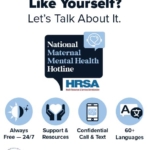Several weeks ago, the US Preventive Services Task Force (USPSTF) issued recommendations that all pregnant and postpartum women should be evaluated in order to determine risk for depressive illness and suggests that women at increased risk should be referred for counseling. The hope is that if we can identify the women at highest risk for depressive illness during pregnancy and the postpartum period, then we can introduce an opportunity to prevent depression in this setting.
But the USPSTF recommendations somewhat vague when it comes to telling clinicians exactly how to identify women at greatest risk in this setting. The USPSTF includes a fairly long list of risk factors which have been associated with the development of perinatal depression, including a personal or family history of depression, history of physical or sexual abuse, having an unplanned or unwanted pregnancy, current stressful life events, low socioeconomic status, and lack of social or financial supports.
Given the length of this list and the time and sensitivity required to interview patients about their history of psychiatric illness and trauma, many obstetric providers may not feel entirely comfortable or properly trained to make this type of assessment. Another issue is that this list does not help quantify risk. Some of the items on this list, such as being unmarried, are relatively weak or inconsistent predictors of risk, whereas others, such as a history of depression, especially when associated with a previous pregnancy, are robust predictors of risk.
If we want this type of recommendation to launch successfully, we need to provide obstetric providers with adequate training and guidance to help clinicians implement these recommendations. Over the last decade, we have advocated for universal screening for perinatal mood and anxiety disorders and have increased our efforts to educate both patients and providers; however, we continue to see sizeable gaps in terms of identifying perinatal women at risk and delivering care to this population.
What About the Postpartum Depression Predictors Inventory?
One thing that might make this endeavor more manageable is to give obstetric providers an algorithm or instrument that could be used to reliably identify women at increased risk for perinatal depression. While we have various instruments which can be used to identify women who are experiencing episode of depression, there are fewer options in terms of instruments or questionnaires which could be used to identify women at increased risk for perinatal depression.
The Postpartum Depression Predictors Inventory or PDPI is one such instrument. The PDPI was developed by Cheryl Beck in 1998 and is a checklist of risk factors derived from two meta-analyses of postpartum depression risk factors. The first rendition of the PDPI included eight risk factors: prenatal depression, prenatal anxiety, history of previous depression, social supports, marital satisfaction, life stress, child care stress, and maternity blues. The PDPI was revised in 2002 based on the results of an updated meta-analysis. The PDPI-Revised includes 13 risk factors, adding unplanned pregnancy, self-esteem, marital status, socioeconomic status, and infant temperament to the previous list or risk factors.
While the PDPI was designed to be used both during pregnancy and the postpartum period in order to help clinicians identify women at increased risk for postpartum depression, it has never been widely used as a screening tool. In fact, Dr. Beck, the creator of the PDPI, notes, “The PDPI-Revised is not a self-report questionnaire, but instead is designed to be administered via an interview conducted by a clinician. The interview format provides a woman with an opportunity to discuss her experiences and any problems she may be experiencing regarding these risk factors… The purpose of the PDPI-Revised is not to calculate a cutoff score above which a woman is flagged as at high risk for developing postpartum depression.”
So there you have it. This instrument is designed to guide a discussion, but it has not been crafted to screen for women at high risk.
So How to Identify Women at Highest Risk?
While there are many factors which modulate risk for perinatal depression, there are some that are stronger predictors of risk than others. Clinically the vast majority of the women we see with perinatal depression are women who report histories of mood or anxiety disorders prior to pregnancy. In these women, the episode of depression emerging during pregnancy or the postpartum period is not the first but represents a recurrence of a preexisting condition. This observation may reflect a bias given that a large proportion of the patients we see in our clinic are women with a psychiatric diagnosis who are planning pregnancy and wish to discuss the safety of psychotropic medications during pregnancy and the postpartum period.
That said, the few studies which have looked at a history of depression as a predictor for perinatal depression have clearly shown that preexisting depression is one of the most robust predictors of perinatal depression. One of the largest studies included 1662 pregnant women recruited at their first prenatal visit to one of eight obstetric practices in the Boston area (Rich-Edwards et al, 2006). According to this study, the strongest risk factor for antenatal depressive symptoms was a history of depression (OR?=?4.07; 95% CI 3.76, 4.40). The strongest risk factor for postpartum depressive symptoms were depressive symptoms during pregnancy (OR 6.78; 95% CI 4.07, 11.31) or a history of depression before pregnancy (OR 3.82; 95% CI 2.31, 6.31).
We don’t yet know how to best help obstetricians to screen for women at high risk for perinatal depression. However,ver, if we want to succeed in this setting, we have to make it simple. These two questions are a good place to start and are likely to identify the women at highest risk for perinatal depression:
Was there ever a period of time when you were feeling depressed or down or when you lost interest in pleasurable activities most of the day, nearly every day, for at least 2?weeks?
Has a health care professional ever told you that you were depressed? Have you ever taken a medication for depression?
Ruta Nonacs, MD PhD
Postpartum depression predictors inventory–revised.
Beck CT. Adv Neonatal Care. 2003 Feb;3(1):47-8. Free Article
Psychometric assessment of the Postpartum Depression Predictors Inventory -Revised.
Records K, Rice M, Beck CT. J Nurs Meas. 2007;15(3):189-202.
Rich-Edwards JW, Kleinman K, Abrams A, Harlow BL, McLaughlin TJ, Joffe H, Gillman MW. J Epidemiol Community Health. 2006 Mar;60(3):221-7. Free Article







The vast majority of postpartum depression is explained by a history of depression.
https://www.ncbi.nlm.nih.gov/pmc/articles/PMC5462547/
Thanks for sharing such an amazing article, really informative !!
(http://www.seyyone.com/)
Thanks for the post. Nice information.